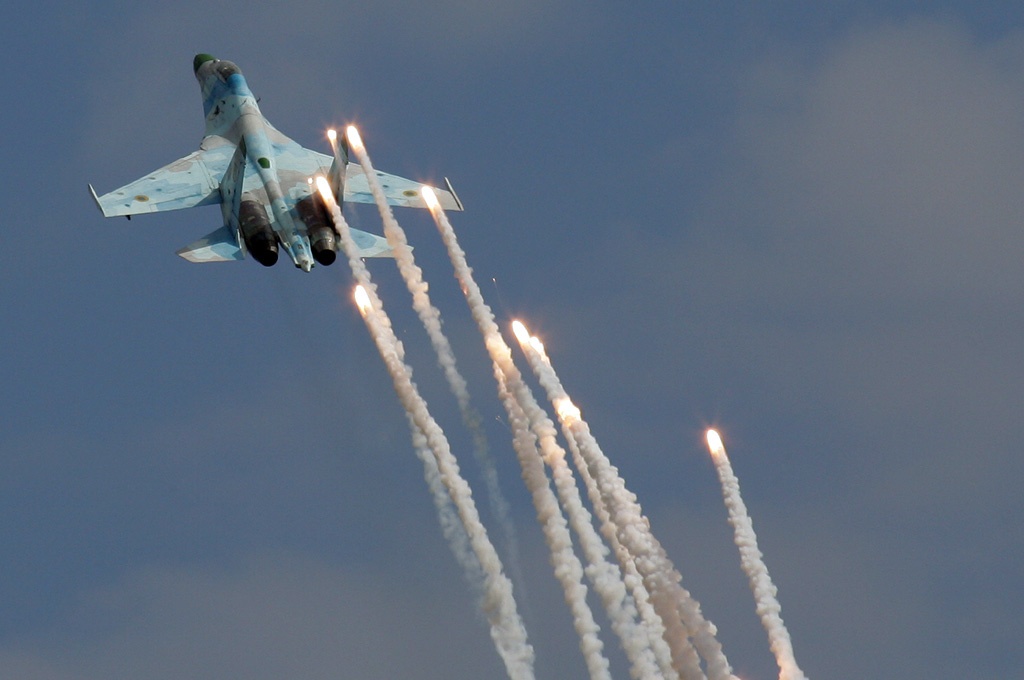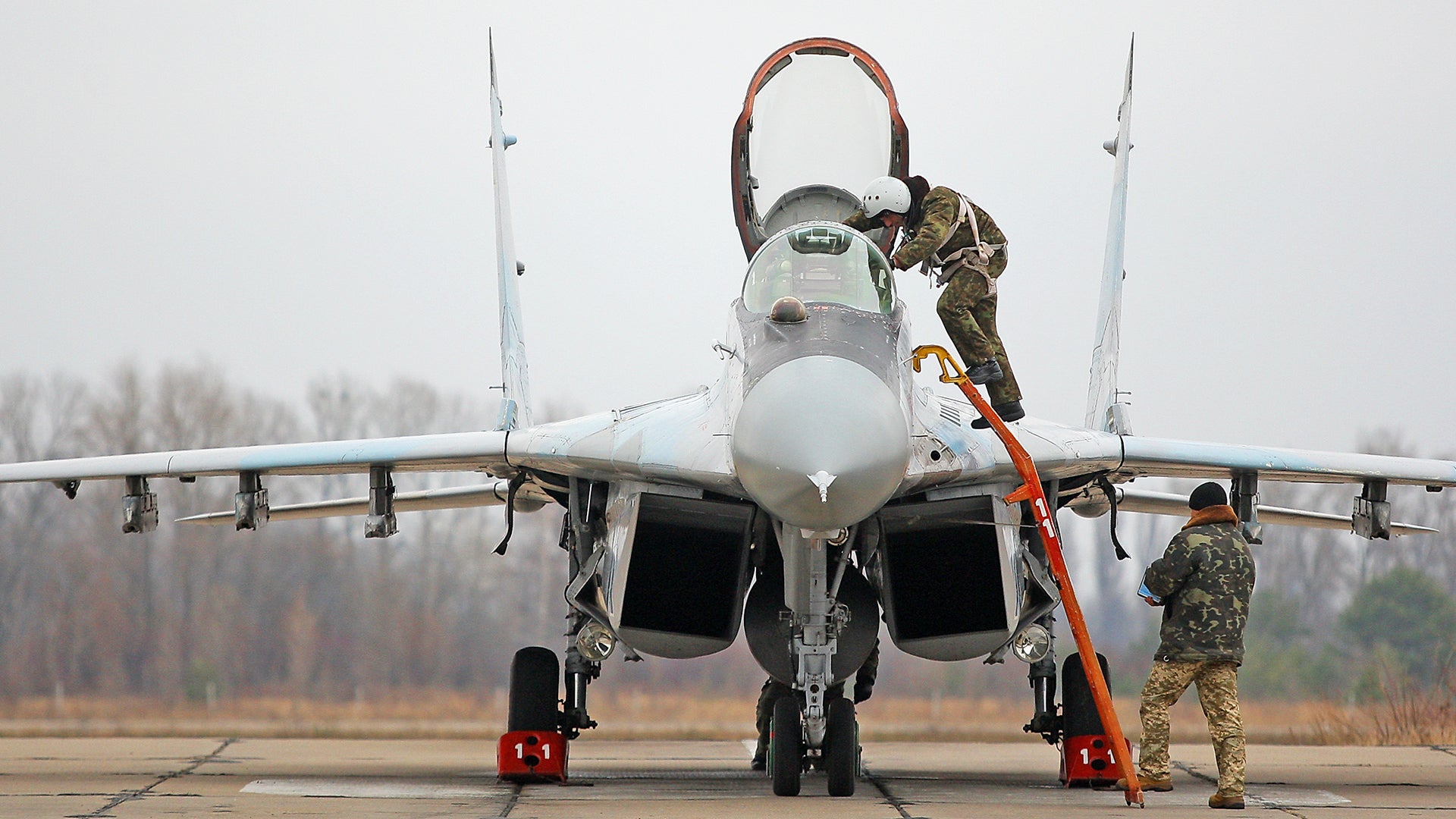In a conflict that’s so far confounded many expectations, it’s no exaggeration to say that the performance of the Ukrainian Air Force in its response to Russia’s invasion has been one of the more surprising aspects. Rather than being wiped out on the ground and in the air in the first few days of the war, as many had predicted, Ukrainian airpower has instead refused to buckle in the face of a much larger and technologically more advanced opponent. Amid fanciful claims of aerial victories posted by Ukrainian officials, it remains unclear as to exactly how the Ukrainian Air Force has not only survived against the odds but successfully helped prevent the Russian Aerospace Forces, VKS, from achieving aerial superiority. Now, a pair of interviews with serving combat pilots shed some light on how the Ukrainian Air Force is fighting back.
The first of these is an article published today in the New York Times that includes an interview with a Su-27 Flanker pilot, identified only as Andriy. Meanwhile, another Ukrainian Air Force pilot, identified only by his callsign ‘Juice,’ spoke to CNN’s Anderson Cooper during a video interview.

Su-27 pilot Andriy talks about undertaking quick reaction alert duty including night-time scrambles to meet incoming VKS jets. Without even running full pre-flight checks, the Flanker is scrambled from a hangar, indicating that at least some of the Ukrainian jets are kept out of sight of potential attackers, perhaps in hardened aircraft shelters for additional protection, rather than operating from flight lines.

“Every time when I fly, it’s for a real fight,” Andriy explains. “In every fight with Russian jets, there is no equality. They always have five times more” aircraft in the air. Andriy, who is 25 years old, has reportedly flown 10 missions in the war so far and has more than one aerial kill to his name.
“I mostly have tasks of hitting airborne targets, of intercepting enemy jets,” Andriy explained. “I had situations when I was approaching a Russian plane to a close enough distance to target and fire. I could already detect it but was waiting for my missile to lock on while at the same time from the ground they tell me that a missile was fired at me already.”
Reflecting on shooting down a Russian jet, he said, “I am happy that this plane will no longer bomb my peaceful towns. And as we see in practice, that is exactly what Russian jets do.”
Apparent wreckage of an R-27 (AA-10 Alamo) air-to-air missile fired during the air war in Ukraine. These weapons are used by both Russia and Ukraine:
Andriy apparently survived this encounter by making evasive maneuvers to defeat the incoming missile, although he likely also made use of his jet’s self-protection systems, too. These include a radar warning receiver to alert the pilot to radio-frequency threats and chaff and flare cartridges to spoof incoming missiles.

“I only have to use my skills to win,” said Andriy. “My skills are better than the Russians. But on the other hand, many of my friends, and even those more experienced than me, are already dead.”
While the scenario described has the Su-27 pilot racing to launch their jet from a hangar, receiving information on the target or targets only once they are airborne, the exact remaining operating locations of the Ukrainian Air Force have not been officially disclosed. Airbases and airports have come under intense bombardment, especially from Russian missile strikes, and it seems that the air force has responded to this ongoing threat through the use of distributed operations. These may include the use of smaller airstrips in the west of the country, partially damaged longer runways, or portions of highways. Operations from the road are something that the Ukrainian Air Force has practiced in the past, as seen in the video below, which shows a Su-27 striking a road sign:

Similarly, the number of aircraft still operated by Ukraine has not been revealed. According to David Deptula, a retired U.S. Air Force lieutenant general and now a senior scholar at the U.S. Air Force Academy, the Ukrainian Air Force currently has around 55 operational fighters. Earlier this month, a Pentagon official put the number at 56, or 80 percent of the pre-war strength.
Regardless, the U.K. Ministry of Defense considers that “The Ukrainian Air Force and Air Defense Forces are continuing to effectively defend Ukrainian airspace,” and that “Russia has failed to gain control of the air and is largely relying on standoff weapons launched from the relative safety of Russian airspace to strike targets within Ukraine.”
Nevertheless, even without attrition to the enemy, the Ukrainian Air Force’s operational capabilities will be eroded as the fighting continues, due to the simple fact that the available aircraft are being pushed much harder than they would be in peacetime. So far, efforts been made to obtain additional MiG-29s from NATO stocks have proven unsuccessful. Compounding matters, Russia struck the Lviv State Aircraft Repair Plant, destroying a large hangar and causing other damage to a facility that performs major maintenance on the MiG-29.
Overall, the New York Times estimates that the Ukrainian Air Force flies between five and 10 sorties daily, while the VKS conducts around 200. Other estimates put Russian sortie totals higher, with one unnamed senior U.S. defense official yesterday mentioning 300 in the previous 24-hour period. While the Ukrainian sortie generation is also assessed to be on the increase as of late, the totals still reflect the primacy of ground-based air defenses to the campaign.
The article also points to the advantage offered to the Ukrainian Air Force by the country’s aforementioned ground-based air defense systems, which, as we have pointed out in the past, have been able to put up a defensive umbrella that threatens VKS aircraft over most of Ukraine. This works both ways, though, and Russia seems to have been able to establish similar missile defenses over parts of Ukraine.
At the same time, and crucially, the cooperation between Ukrainian fighters and mobile surface-to-air missile systems seems to have been broadly effective, although it would not be a surprise if at least some Ukrainian Air Force jets had fallen to friendly fire in what’s a notably dense air defense environment.
Most VKS missions have been flown at night, according to the New York Times, apparently in an effort to reduce vulnerability to ground-based air defenses, although this claim is otherwise hard to verify.
A daylight mission flown by a VKS Su-25 ground-attack aircraft:

“Ukraine has been effective in the sky because we operate on our own land,” Yuriy Ihnat, a Ukrainian Air Force spokesman told the New York Times. “The enemy flying into our airspace is flying into the zone of our air defense systems.” Effectively, this cooperation means that the Ukrainians can set traps for the VKS, with manned fighters driving enemy aircraft into sectors of airspace where they will be confronted by surface-to-air missiles. This reality may also account for the apparent uptick in suppression of enemy air defense (SEAD) sorties that are being flown now by the VKS.
A VKS Su-35S fighter armed with Kh-31P series missiles for a SEAD mission over Ukraine:
The Ukrainians are also showing a degree of ingenuity in overcoming the odds in the air war, with the same article reporting that a network of volunteer observers on the ground is on alert to report any VKS air activity to the military, in an effort that parallels the work of civil defense observers in the Battle of Britain during World War II, for example. Another example provided is the donation of civilian navigation equipment to the air force by civilian pilots.
Meanwhile, Juice provided a slightly more nuanced description of the current air war picture. He stated that while the VKS was currently not able to gain full air superiority, it had “almost” achieved that aim. Ukraine, for its part, was hampered by limited numbers of aircraft and air defense systems, all of which are older equipment.
Nevertheless, the “Russians have a lot of losses, and they have a fear of our air defense,” Juice said. “So they couldn’t fly here just comfortable for them.”
A U.S. defense official yesterday attributed the lack of Russian air superiority to a “very creative air defense posture” by Ukraine.”
“I’m sitting just near [the] aircraft or just in the cockpit,” Juice added, “and my colleagues from the radar units, they’re just giving me the information about targets, and I’m taking off and intercepting these threats.”

“We need efficient ground air defense systems,” Juice said, “and we need some other fighter jets to gain the air superiority to fight effectively against these threats.”
While the New York Times describes “Top Gun-style aerial dogfights, rare in modern warfare … raging above the country.” The truth, it seems, is somewhat less glamorous, but there’s no doubt that Ukrainian Air Force tactics are continuing to frustrate the VKS and it’s likely that Ukrainian fighter jets — MiG-29s and Su-27s — have contributed to the losses that Russia has sustained in the air. Ukrainian officials claim that no fewer than 97 fixed-wing Russian aircraft have been brought down by the Ukrainian Defense Forces (including ground-based air defense systems as well as fighters). The exact number is not known and is likely to be debated for years.
At this stage, it’s also not possible to determine with any authority which of these Russian aircraft were downed by Ukrainian Air Force fighters, but interviews with its pilot suggest that they are, at least, regularly encountering VKS aircraft in the skies over Ukraine, as well as cruise missiles, some of which have reportedly also been shot down by Ukrainian jets.
The United States and other allies continue to supply Ukraine with shoulder-fired surface-to-air missile systems and are now actively pursuing transferring more advanced, but familiar SAM systems to Ukraine, and there may even be clandestine efforts to provide them with additional aerial assets. However, hopes of transferring fighters, at least publicly, look to have stalled, after the Pentagon said it would not support the proposed transfer of Polish MiG-29s for a number of reasons. These included fears that it could provoke serious retaliation from Russia. With that in mind, Andriy, Juice, and their air force colleagues will face an increasing challenge as losses mount and serviceability decreases as the war continues. At this point, it looks inevitable that ground-based systems will have to bear the brunt of the effort if Ukraine is to continue to deny Russia the opportunity to establish true air superiority.
Contact the author: thomas@thedrive.com
